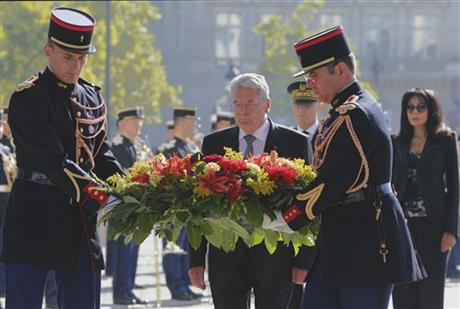
By SYLVIE CORBET
German President Joachim Gauck and French Deputy Minister in charge of French citizen living abroad and French speaking countries Yamina Benguigui, right, lay a wreath at the Tomb of the Unknown Soldier beneath the Arc de Triomphe in Paris, Wednesday, Sept. 4, 2013. Gauck is on a two-day state visit in France. (AP Photo/Jacques Brinon, Pool)
ORADOUR-SUR-GLANE, France (AP) — With hugs and hand-holding in a solemn tribute to those killed, the presidents of Germany and France on Wednesday visited a ghost town left behind after the largest massacre in Nazi-occupied France nearly seven decades ago.
The trip by German President Joachim Gauck, accompanied by France’s Francois Hollande, to the southwestern French town of Oradour-sur-Glane was the first by a serving German leader. The town is today a phantom village, with burned-out cars and abandoned buildings left as testimony to its history.
On June 10, 1944 — four days after the Allied D-Day landings in Normandy — an SS armored division herded hundreds of civilians into barns and a church, blocked the doors, and set the town on fire. A total of 642 men, women and children died.
The visit aimed to underscore French-German postwar reconciliation, and the importance of remembering Nazi atrocities that included the slaughter of millions of Jews, homosexuals, Gypsies and others during the Holocaust.
“We can today only understand with difficulty how ‘totally normal men’ became unscrupulous murderers,” Gauck said in prepared remarks in a speech at a memorial ceremony. “And it happened here in Oradour, in the middle of Europe, and so many other places.”
The killings were believed to have been ordered by a battalion commander in retaliation for the kidnapping of a German soldier by the French Resistance.
The battalion commander, Adolf Diekmann, apparently believed that the kidnappers were in or connected to Oradour-sur-Glane. Diekmann he was killed in action a short time later, and little more is known about his reasoning.
Only six people survived. The two leaders were joined by one of them — 88-year-old Robert Hebras — who they assisted during a visit to the blown-out wreckage of the church, noting the remains of a charred baby carriage inside. Hebras’ voice cracked with emotion as he explained what happened.
But even now, the fallout from the massacre lives on: Six men from the fanatical SS “Das Reich” division that was responsible for the massacre have been under investigation in Germany for almost two years on possible charges of murder or accessory to murder.
Dortmund prosecutor Andreas Brendel, who is leading the investigation, said Wednesday he had visited France this year to interview witnesses and review archives. He said he expects to determine by year-end whether there is enough evidence against the suspects to file charges against them.
Gauck alluded to the pain that some in France feel because the case remains unresolved.
“When I look today into the eyes of those who have been marked by this crime,” he said, “I can say I share your bitterness over the fact that the murderers have not been brought to justice — that the most serious of crimes has gone unpunished.”
___
Associated Press writers David Rising in Berlin and Jamey Keaten in Paris contributed to this report.



